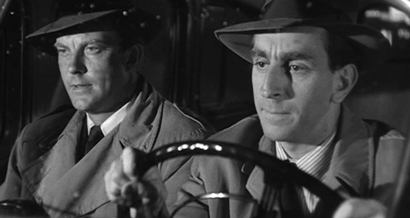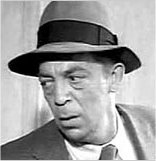
 |
|
|
|
There seems to be some confusion about what constitutes a "B" picture, as the term is frequently still applied as meaning "low budget", "no stars" or "no class". The term originally applied to a second tier of film production intended for second feature status in double bills. When television came along these kinds of movies slowly migrated to the tube, and slightly older pictures were recycled as second features. Back in the 1940s all of the main studios had B production units, churning out genre quickies. RKO under Howard Hughes started turning out a series of very inexpensive B crime-suspense thrillers in 1949, with titles like The Clay Pigeon, The Threat and The Tattooed Stranger. Each is barely longer than an hour. 
Just under an hour in length, Follow Me Quietly certainly qualifies as a classic "B". Graduating from the RKO short subjects department, director Richard Fleischer learned to shape a film with a minimum of resources. Tattooed Stranger was filmed by a short-subject crew (surely a Howard Hughes cost-cutting idea) but it enjoyed the benefit of authentic New York locations. Fleischer had to use the same standing sets seen in RKO pictures since the 1930s. The film could be a prototype for the serial killer / police procedural suspense thrillers of the 1990s. Detective Lieutenant Harry Grant (William Lundigan) and his partner Sgt. Collins (Jeff Corey) are getting nowhere tracking down "The Judge", a maniac who murders only when it rains, leaves no clues and sends demented messages to the police. Told to be 'more imaginative', Harry fabricates a life-sized dummy of The Judge, incorporating everything known about him. It's used in line-ups and its photo is circulated to possible witnesses. Persistent writer Ann Gorman (Dorothy Patrick) hounds Harry to secure an exclusive story on The Judge, forming a relationship that's as much a flirtation as it is professional. Her knowledge of pulp magazines gives Harry the clue that tightens the dragnet on the mysterious killer. A few months later the inattentive and indecisive Howard Hughes would be micro-managing movies like Follow Me Quietly, ordering extensive re-shoots and sometimes shelving projects for years. Here at the beginning of his RKO regime we instead see a B-picture thrown together willy-nilly. Follow Me Quietly is from an Anthony Mann story idea recovered from the RKO files, and the finished script is none too polished. Stuck in charge of a horrible crime spree, Lt. Harry Grant seems more inconvenienced than obsessed, and spends less time investigating than he does engaging in cutesy banter with the amusingly forward Ann. She argues that it's her journalistic right to crash a murder investigation. She demonstrates her professional commitment by breaking into Harry's apartment to wait for him on his sofa, wearing an attractive dress. 
Tyro director Richard Fleischer remembered being left to his own devices to make the movie work, and was proud of the finale he devised, a complicated chase filmed in an oil refinery. His camera angles are exciting but the action is more than a little frustrating. Harry Grant fumbles the capture at least twice, and we wonder why he doesn't simply handcuff his unpredictably quarry to a rail and wait for the backup officers. As both Follow Me Quietly and White Heat were in production at the same time, we can't assume that Fleischer was imitating the conclusion of the James Cagney epic. But Fleischer learned an important lesson on getting the maximum from a nominal budget -- the intense ending makes his film look like a much bigger production. Had the script or performances been given more of a sense of urgency (a quality Fleischer was quick to instill in subsequent pictures) Follow Me Quietly might have made a bigger impression. Veteran cinematographer Robert DeGrasse's mysterious visuals offer solid support for many of the less exciting earlier scenes. Aware that rainfall will cue another murder, we react when raindrops begin to fall outside Lt. Grant's office window. Harry walks ominously toward the camera to emphasize the need to "think like the killer", a theme that launched a thousand psycho killer movies from The Silence of the Lambs forward. But Harry never seems affected by the killer's actions. The Judge's demented notes about ridding the world of evil are another dead end, because no connection becomes apparent between those ravings and the victims, who seem to be chosen at random. Only one thematic thread pays off, when The Judge freaks out at the sight of liquid dripping like rain from holes shot in a pipe by a police machine gun. 
The idea that really sticks with viewers is the strange dummy of The Judge. The film does not fully exploit the unsettling image of the faceless mannequin wearing a hat. Harry talks to it, but never seems to be falling under its spell. We instead note that in some individual shots the dummy seems to be played by an actor. The Follow Me Quietly squanders the potential of this spooky dummy. Harry talks to the dummy, its face turned to a rainy window, and a few moments later he leaves the room with Sgt. Collins. We then discover that the dummy is really The Judge himself: the killer has crept into Harry's office and taken the mannequin's place. It's a nifty idea that doesn't build beyond the momentary surprise-reveal. 1 Ideally, the gag should have been saved for a more crucial scene, perhaps nearer the climax. Either that, or the film needed to establish that The Judge is carrying on a surreptitious counter-investigation of his own. That possibility evaporates when the killer is revealed to be a rather sad-looking schmoe, and not a brilliant criminal madman. Come to think of it, if The Judge were a more sinister maniac stalking Harry or Ann, the title "Follow Me Quietly" would make a lot more sense. 
Follow Me Quietly has all the ingredients for a superior mystery thriller, and is in sore need of a quick, smart re-write. It carries the seed of major genre innovations to come. With additional murder scenes and gore, it would resemble an Italian giallo by Mario Bava or Dario Argento. That image of the faceless dummy looks very much like the masked slasher in the disturbing Blood and Black Lace. Good-looking William Lundigan began as a radio announcer and had a long career as a lower-middle range leading man and character actor; he spent the better part of the 1950s as a traveling spokesman for Chrysler cars. Dorothy Patrick does her best to inject some spirit and sexuality into the film; she moved to MGM for a few years and then worked for Richard Fleischer again in the noir Violent Saturday. Dorothy also has a prominent role in Joseph M. Newman's 711 Ocean Drive. Pro character specialist Jeff Corey was in heavy demand for two more years, before the blacklist brought his film career to a screeching halt. Corey became a noted acting teacher and did not return to feature work for eleven years. Douglas Spencer (the reporter in The Thing from Another World) has an effective bit as a creep who falsely claims to be The Judge. He's a lot more interesting than the film's forgettable real Judge, played by 'sad eyes' specialist Edwin Max (pictured just above). 
The Warner Archive Collection DVD-R of Follow Me Quietly is in fine shape, both picture and sound. Robert DeGrasse's night scenes have a good noir feeling, especially in the rainy scenes. The daytime work cannot hide the familiar RKO city back lot with its short blocks and narrow streets. The movie makes liberal use of stock shots -- the same angle of suspects being unloaded from a cop car appears in He Walked by Night, Without Warning! and probably ten other movies. The RKO optical department superimposes hard rainfall over a shot of a cop car as it speeds to a murder scene... and raises a cloud of dust in the supposedly soggy streets.
On a scale of Excellent, Good, Fair, and Poor,
Follow Me Quietly rates:
Footnotes:
1. This brings up a strange effect in certain movies that blur the line between "what is real" and "what we're supposed to accept as real". The Creature from the Black Lagoon is a scaly monster, but anyone older than a credulous child realizes that it must be a man in a rubber suit. So movies about the Creature have an additional level of complexity (beyond the theatrical acceptance of actors as characters) that puts pressure on the "suspension of disbelief". We enjoy seeing the monster swim underwater, but we also watch to see if he has some hidden oxygen supply. The same thing happens whenever a character is chased to a high location, as in the conclusion of Follow Me Quietly: the moment a fall seems likely, we're conditioned to expect to see the actor substituted by a dummy. We watch the dummy of The Judge very carefully, because we want to see if it could really fool anybody. In more than one scene, the dummy appears to be "performed" by a costumed man, either for a specific effect or for ease of shooting. So when the dummy suddenly 'comes to life', we aren't as surprised as we should be. Outside the film's fantasy we already suspect that the dummy is a live person.
Modern CGI effects have erased this uneasy truce between filmmaker and audience, essentially destroying one of the main pleasures of movies. We rarely expect anything to be "really real", not even in movies without fantastic content. Ordinary pictures generate false backgrounds and alter details as a matter of course: seeing Harrison Ford perform at the Grand Canyon does not mean that he ever went there. No suspension of belief is required, because nobody believes anything they see in the first place. Movies with fantastic special effects are now strangely uninteresting, when they were once little islands of movie magic. The old Suspension of Disbelief contract is no longer enforceable.
Reviews on the Savant main site have additional credits information and are often updated and annotated with reader input and graphics. Also, don't forget the 2011 Savant Wish List. T'was Ever Thus.
Review Staff | About DVD Talk | Newsletter Subscribe | Join DVD Talk Forum |
| ||||||||||||||||||